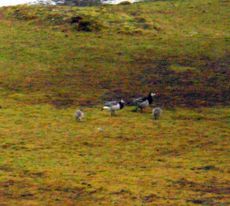Conditions in the Arctic vary rapidly, and local ecosystems are very simple (no rodents or hares, for example, in this part of Svalbard) (no worms, no slugs, but a few insects). There are many other animals around, though, and they are mostly unaware that humans can cause a threat. In the case of polar bears, this is justified … (and before anyone asks, no, I have not seen a bear yet: just a pawprint on the beach once, and that’s as far as I am keen to go …)
The bay we are on is called Isbjjørnhamna, after the ice-breaker “Isbjørn” used in early 20th century expeditions. It also means the bay of the polar bears, and Jarek tells me that this is often used in winter by bears migrating from eastern to western Svalbard. The area was used by Norwegian hunters until the 1950s (when the station was built). Polar bear hunting is banned since 1973 in Svalbard, and only self-defence is allowed. Some bears are said to cross the ice-covered seas in winter to move all the way to Greenland … Impressive!
The Polish Polar Station has two big Arctic dogs, used to extreme weather and sometimes seen lazily soaking up the mist on the cold tundra, in the same way that dogs back home would soak up the sun on the lawn. They are used to warn of bears, although I was told one was eaten by a polar bear a few years ago … There are also plenty of geese, roaming around with a few fluffy chicks and being very protective. The first night, I heard a commotion outside before going to bed, and saw an Arctic fox running away with something small in its mouth, being pursued for a few metres by some angry geese. With seabirds, this is apparently their primary food source during the summer, and the local guidebook assures me they have plenty of food in this season.
Other animals roaming happily around us are reindeers: three of them can be seen happily munching on anything that grows, from lichen to moss to a few clumps of grass or even flowers. They are not disturbed by humans walking around, and they come and go at leisure around the bay.

Seabirds come in all sorts, from black guillemots to eiders (I saw one flying across our boat this morning, or at least I think it was one), and little auks, nice small black-and-white birds with a short beak. Several of the scientists working at the station study them: the birds have one chick per brood, and one brood per year. Both parents take equal care of raising their young, often with the father staying in the nest after hatching whilst the mother moves around. The scientists study prolactin, the hormone regulating bonding behaviour, and stress hormones. They could tell me everything about these birds’ migration patterns too: they travel to the deep sea far away, where they gorge on plankton …

Respond